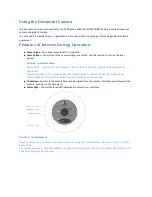
V1.02
Thom Hogan’s Complete Guide to the Nikon D300
Page 428
self timer (in other words, if you haven’t taken the picture
after 30 seconds, the camera takes the picture and flips the
mirror back to the down position).
Live View
Nikon added a significant new ability to the D300, something
they call Live View. Live View allows you to see an image on
the color LCD on the back of the camera
prior
to taking a
picture. The preview image is much like what you’d see from
a video camera (i.e., it updates constantly). Live View may be
used for up to an hour at a time, at least if the ambient
temperatures are relatively low.
Live View has a number of primary advantages:
• Evaluate
focus.
Both the actual point of focus and the
depth of field can be more carefully evaluated using Live
View, allowing you to optimize both.
Caveat:
this works
best with either manual focus or with AF-S lenses where
you can override the camera’s focusing decisions.
• Set correct white balance.
Perhaps the most intriguing and
useful of the possible uses of Live View is the ability to
look at white balance settings in real time and pick the
one that is most appropriate for the scene.
Caveat:
you’re
checking color on a display that is not finely calibrated, so
you can still be off.
• Frame when you can’t look through the viewfinder.
The
classic photojournalist position of camera-over-the-head
while in crowds suddenly can still provide you some
useful framing feedback. Likewise, the classic macro
photographer down-on-the-ground position doesn’t mean
having to contort your body to look through the
viewfinder.
Caveat
: the color LCD doesn’t rotate or pivot,
meaning that you’re often at angles to it that make it hard
to see; you may need to use an external monitor in some
situations.
• Contemplate still life framing.
With non-moving subjects,
being able to see the composition in the flat two-
dimensional representation that the final picture will take
















































